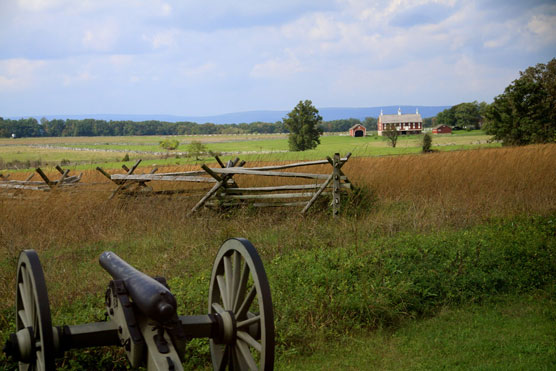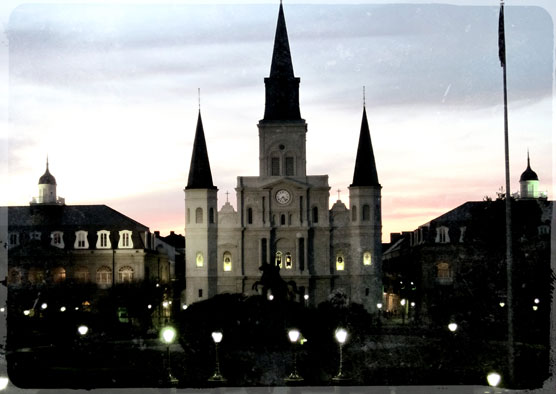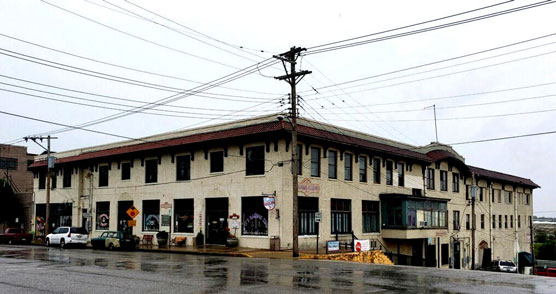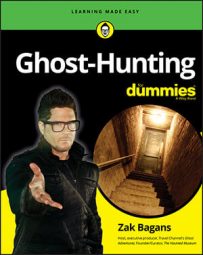Nearly every community in the United States can claim at least one haunted house. Some have dozens, with the degree of how haunted each home might be varying by its history and, of course, by the person telling the story. Regardless of the truth behind every story, there is no denying the fascination of ghosts and the supernatural have to a large percentage of our population. Yes, there are still many who scoff at the existence of ghosts. However, many great people, even American presidents like Abraham Lincoln, Harry Truman and Franklin Delano Roosevelt, have harbored a belief in the spirit world.
Ghost stories are an integral part of America, and so I would like to take you along for a coast-to-coast (or perhaps we should say ghost-to-ghost) tour of the most haunted places in America.
Virginia City, Nevada
Virginia City — where we filmed the first Ghost Adventures documentary — developed as a boomtown with the 1859 discovery of the Comstock Lode, the first major silver deposit discovery in the United States. Dozens of mines opened, drawing miners, suppliers, saloon owners, prostitutes, and outlaws, from all over the west. The population peaked in the mid-1870s, with an estimated 25,000 residents. In October 1875, what was called the Great Fire destroyed most of the city and left 2,000 people homeless. The city was rebuilt, but the output of the mines began to decline a few years later, ending Virginia City’s glory days around 1880.The town remains today as a time capsule of the 1870s. Many of the grand buildings remain but now serve as home to spirits. Haunted places in Virginia City include the Silver Queen Hotel, Piper’s Opera House, Mackay Mansion, Gold Hill Hotel and Saloon, and, of course, the Old Washoe Club, which also makes the list as one of the most haunted spots in the country.
Gettysburg, Pennsylvania
The small town of Gettysburg in Pennsylvania is one of the most active paranormal hot spots in the country. It was at this place where Union troops under command of General George Meade clashed with Confederate soldiers under General Robert E. Lee, resulting in the bloodiest battle of the Civil War. Over the days of July 1 to 3, 1863, more than 51,000 soldiers were killed, wounded, or went missing. Courtesy of American Hauntings.
Courtesy of American Hauntings.The Gettysburg battlefield.
The carnage from the battle has left a permanent mark on the town, and there are literally dozens of haunted places in Gettysburg and on the surrounding battlefield, including the Jennie Wade House (once home to the only civilian killed during the battle), Devil’s Den, Little Round Top, Iverson’s Pits, National Soldier’s Orphan Homestead, Gettysburg Engine House, and many others.
New Orleans, Louisiana
New Orleans is one of the most unique cities in America — and one of the most haunted. Founded by the French in 1718, it was a colony into which France dumped its prisoners, criminals, and prostitutes. Built on the swamps of Louisiana, the city flew the flags of both France and Spain before becoming an American city in 1804. Destroyed once by fire, inhabited by pirates and voodoo priests, devastated by hurricanes and disease, the scene of a bloody battle during the War of 1812, and held by both Confederate and Union forces during the Civil War, the city has seen more than its share of history — and more than its share of ghosts. Courtesy of American Hauntings.
Courtesy of American Hauntings.Jackson Square in New Orleans.
Ghosts are found everywhere in New Orleans, from homes to hotels, churches, taverns, restaurants, and even alleyways. Some of the most famous haunted places include St. Louis Cemetery No. 1, Bottom of the Cup Tea Room, Beauregard-Keyes House, Gardette-LePrete Mansion, Andrew Jackson Hotel, Antoine’s, Old Absinthe House, Lafitte’s Blacksmith Shop, Bourbon Orleans Hotel, and, of course, the LaLaurie Mansion, which was known as The Haunted House in the city for decades.
Hollywood, California
Although it’s officially been a part of Los Angeles for many years now, Hollywood is a world of its own. The “movie capital of the world” has drawn would-be actors, dreamers, and movie buffs since the first silent filmmakers came to California in the early 1900s. What began as a scheme for moviemaker Mack Sennett to make extra money with a low-cost housing development called Hollywoodland became a movie colony for artists, writers, and actors who came west to make it big. Today, Hollywood remains not so much a city, but a state of mind. It hasn’t been incorporated since 1910, but it retains a strange allure for those with an interest in history, crime, and hauntings and for those who lived their life against the backdrop of the silver screen.Dozens and dozens of hauntings are in Hollywood, most connected to the broken dreams faced by those who came to this place — and never left. There are haunted movie studios, haunted cemeteries, and haunted hotels like the Knickerbocker and the Hollywood Roosevelt. Some of the lingering spirits — as famous is death as they were in life — include Rudolph Valentino, Erol Flynn, James Dean, Jayne Mansfield, William Desmond Taylor, Thelma Todd, Sharon Tate, George Reeves, Bob Crane, and even Marilyn Monroe.
Salem, Massachusetts
Salem, located on the northeast coast of Massachusetts at the mouth of the Naumkeag River, was founded in 1626 by Roger Conant and a group of immigrants from Cape Ann. At first, the settlement was named Naumkeag, but the settlers preferred to call it Salem, derived from the Hebrew word for peace. The city grew into a thriving port and one of the largest cities in the state, outside of Boston. Of course, the events for which Salem is best remembered began in 1692. A local physician diagnosed several teenage girls as bewitched, which resulted in the hanging of 19 persons and one being crushed to death. When the hysteria had played itself out the following year, an edict was issued that released all people from prison who had been accused of witchcraft — but by then, the damage was done.It should come as no surprise that an old city known for its rich witchcraft history and maritime trade is home to many legendary ghosts. Spine-tingling tales began as far back as the Salem Witch Trials of 1692, and today, the city is rife with spirited sites, ranging from Bunghole Liquors, a former Prohibition-era funeral parlor to Cinema Salem, an independent movie theater. Other spine-chilling locations include In a Pig’s Eye, Murphy’s, Hawthorne Hotel (named for Nathaniel Hawthorne, author of The House of Seven Gables, which is also in town), Old Burying Point Cemetery, and, of course, the Witch House, or the Corwin House, which was the home to Judge Jonathan Corwin, a lead figure in the Salem Witch Trials.
Savannah, Georgia
Established in 1733 when General James Oglethorpe and 120 colonists decided to build a city on a bluff along the Savannah River, Savannah became the first settlement in the last American colony of Georgia. A few decades later, it proved a strategic port city in the American Revolution and during the American Civil War. In 1778, the British took Savannah and held it until 1782. Eventually, a land-sea force of French and American troops reclaimed the city’s independence. During the Civil War, Savannah suffered from sea blockades so fierce that its economy crumbled. Saved from the fires set by Union soldiers throughout the Southeast, the city was offered by Union General William Sherman as a Christmas present to President Abraham Lincoln. It’s been said that Savannah was spared from fire because General Sherman was so impressed by its beauty that he couldn’t destroy it.Over the centuries, Savannah has suffered devastating fires, war, and yellow fever outbreaks that claimed the lives of thousands. But it survived and rebuilt itself, playing host to resilient citizens — and plenty of ghosts. Haunted places include the site of Gribble House, where notorious ax murders occurred, Marshall House, Factor’s Walk, Madison Square, Moon River Brewing Company, and the infamous Pirate’s House, one of the oldest structures in the city.
San Francisco, California
In 1835, an American, William Richardson, became the first permanent resident of a settlement then known as Yerba Buena. As more people came to the region, California achieved its independence and the town began to grow, but nothing like it would a few years later. On January 24, 1848, the first gold was found at Sutter’s Fort, in the California foothills. Within months, San Francisco (renamed from Yerba Buena in 1847) became the central port and depot of the frenzied Gold Rush. Over the next year, arriving “forty-niners” increased the city’s population from 1,000 to 25,000. The city was lawless and wild, with its Barbary Coast district full of prostitution and gambling. Construction of the Central Pacific Railroad drew thousands of laborers from China and San Francisco’s Chinatown quickly became the largest Chinese settlement outside of Asia.On April 18, 1906, a massive earthquake shook the city. The tremors broke water mains and triggered fires that raged for four days, killing 3,000 people, destroying 25,000 buildings, and leaving 250,000 homeless. The city rebuilt quickly with an improved city center and hosted the lavish Panama International Exposition just nine years later. San Francisco has continued to endure, drawing writers like Mark Twain and Jack London, becoming a center for the 1950s beat poets and for the Haight-Ashbury hippie counterculture that peaked with the 1967 “Summer of Love.”
A city with such a long and storied history is undoubtedly a place to find a myriad of ghosts. Haunted places in San Francisco include some of the most legendary spots in the country, like Alcatraz, the infamous “escape-proof” prison located in the bay, and the Winchester House, which is in nearby San Jose. Other haunted places include Haskell House at Fort Mason, Neptune Society Columbarium, Curran Theater, San Francisco Art Institute, Queen Anne Hotel, and Sutro Baths, which was, in 1896, the world’s largest indoor swimming pool establishment. It burned in 1966, but today accommodates more ethereal guests.
Alton, Illinois
This small Mississippi River town started out as a ferryboat landing in 1814 but soon grew into a thriving port. Author Mark Twain once referred to Alton a “dismal little river town,” largely thanks to the dark history that the city experienced, which included death, disease, disaster, violence, murder, and even the scars of the Civil War. The town has endured over time, becoming home to the first state penitentiary in Illinois (later turned into a Confederate prison during the war) and to Robert Wadlow, the tallest man who ever lived.Dozens of haunted places are in this small community, including the Mineral Springs Hotel, a 1914 building that attracted visitors from all over the Midwest to its mineral baths. The former hotel, shown in the following figure, has more than its share of ghosts, including a man who drowned in the pool, and at least two documented suicides. One of the most active sites is the First Unitarian Church, haunted by a former pastor who hanged himself in the building. Other sites include the old penitentiary, Alton City Cemetery, Enos Apartments, a former tuberculosis sanatorium, and the McPike Mansion.
 Courtesy of American Hauntings.
Courtesy of American Hauntings.The Mineral Springs Hotel.
Vicksburg, Mississippi
The land where Vicksburg is now located had a brutal history before the city was ever settled. The French built Fort-Saint-Pierre (1719) on the high bluffs overlooking the Mississippi River in 1719, but it was wiped out by Native Americans ten years later. In 1790, the Spanish tried again, and a sprawling community grew that was named for a Methodist minister named Newitt Vick. The settlement prospered as a shipping point. Because of its strategic location, Vicksburg was besieged by Union forces for 47 days during General Ulysses S. Grant’s campaign for control of the river during the Civil War. Vicksburg surrendered on July 4, 1863. Since that time, the city has wrestled with racial unrest, has continued as a shipping port, and has become a tourist spot.The town’s long, and often bloody, history has left many ghosts and haunted places behind. Among them are the Vicksburg National Battlefield, McNutt House, the Genella Building, Kuhn Memorial State Hospital, and McRaven Mansion, which was used as a field hospital during the Vicksburg siege. At least 12 Confederate soldiers died here and were buried on the grounds.
Charleston, South Carolina
The new colony of Carolina got its start in April 1670 when travelers landed at Albemarle Point. They named the first community Charles Town in honor of their king, Charles II, but it did not have an auspicious beginning. They battled the French, Spanish, hostile natives, pirates, and rampant disease, but nevertheless, the community grew into a busy seaport. Ships carrying raw materials, deer skins, rice, indigo, and eventually cotton were exported to England and commerce was born. Ships returned heavy with staples and luxuries of Europe which lent a cosmopolitan air to the growing community. Even in its infancy, it had the reputation of being a “Little London” in the semi-tropic wilds of the New World. By 1740, Charles Town was becoming the most critical port in North America for exporting, and an economic boom surged across the colony.The American Revolution brought an end to Charlestown’s golden age. It would be divided by slavery, state’s rights, and eventually, the Civil War. Battles occurred around the city, wreaking havoc on the plantations, homes, and citizens. Thousands died, and parts of the city burned. It would take years to recover, but by the early 1900s, Charleston was again a cultural center. The history of the city was preserved, and it remains one of the most beautiful cities in the South.
With a rich history that dates back more than 300 years, it is no wonder that it has so many ghosts and haunted places. Among the spooky sites are the Battery Carriage House Inn, For Moultrie, Dock Street Theatre, Old Exchange and Provost Dungeon, the Powder Magazine, Pink House, Poogan’s Porch, Boone Hall Plantation, USS Yorktown, and the old Charleston Jail, which is haunted by the spirits of many inmates who died during their imprisonment, from murderers and pirates to prisoners of war and slaves.

